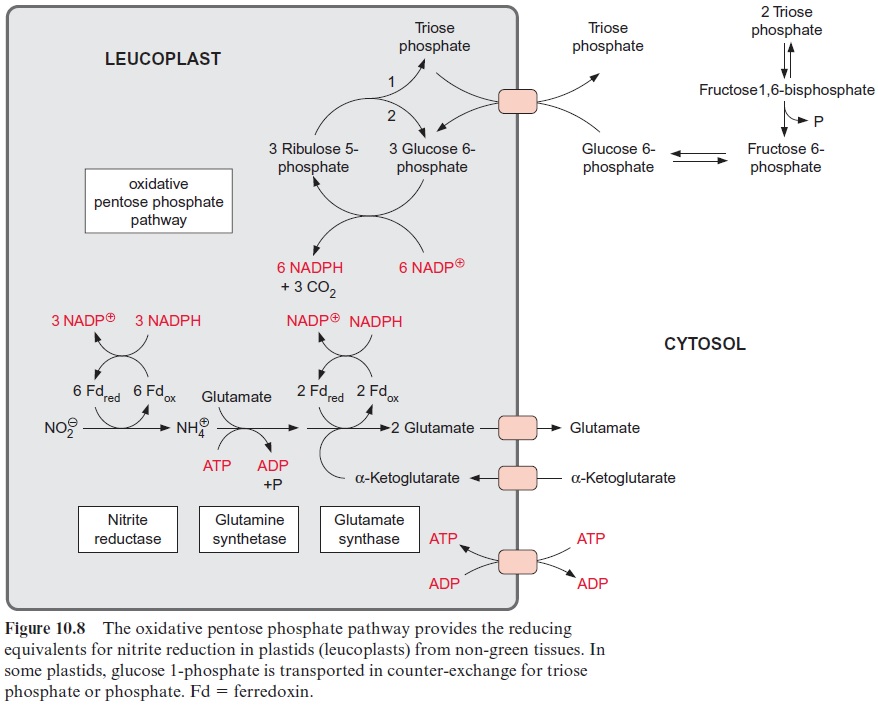Chapter: Plant Biochemistry: Nitrate assimilation is essential for the synthesis of organic matter
Nitrate assimilation also takes place in the roots
Nitrate assimilation also takes place in the roots
As mentioned, nitrate assimilation occurs in part, and in some species even mainly, in the roots. NH4+ taken up from the soil is normally fixed in the roots. The reduction of nitrate and nitrite as well as the fixation of NH4+ proceeds in the root cells analogously to that of the mesophyll cells. However, in the root cells the necessary reducing equivalents are supplied exclusively by oxidation of carbohydrates. In roots the reduction of nitrite and the subsequent fixation of NH4+ (Fig. 10.8) occur in the leucoplasts, a differentiated form of plastids .

The oxidative pentose phosphate pathway in leucoplasts provides reducing equivalents for nitrite reduction
In leucoplasts the reducing equivalents required for the reduction of nitrite and the formation of glutamate are provided by oxidation of glucose 6-phosphate via the oxidative pentose phosphate pathway. The uptake of glucose 6-phosphate proceeds in counter-exchange for triose phosphate. The glucose 6-phosphate-phosphate translocator of leuco-plasts differs from the triose phosphate-phosphate translocator of chloro-plasts in transporting glucose 6-phosphate in addition to phosphate, triose phosphate, and 3-phosphoglycerate. In the oxidative pentose phosphate pathway, three molecules of glucose 6-phosphate are converted to three molecules of ribulose 5-phosphate with the release of three molecules of CO2, yielding six molecules of NADPH. The subsequent reactions yield one molecule of triose phosphate and two molecules of fructose 6-phosphate; the latter are reconverted to glucose 6-phosphate via hexose phosphate isomerase. In the cytosol, glucose 6-phosphate is regenerated from two molecules of triose phosphate via aldolase, cytosolic fructose 1,6-bisphos-phatase, and hexose phosphate isomerase. In this way glucose 6-phosphate can be completely oxidized to CO2 in order to produce NADPH.
As in chloroplasts, nitrite reduction in leucoplasts also requires reduced ferredoxin as reductant. In the leucoplasts, ferredoxin is reduced by NADPH, which is generated by the oxidative pentose phosphate pathway. The ATP required for glutamine synthesis in the leucoplasts can be gener-ated by the mitochondria and transported into the leucoplasts by a plastid ATP translocator in counter-exchange for ADP. Also, the glutamate syn-thase of the leucoplasts uses reduced ferredoxin as redox partner, although some leucoplasts also contain a glutamate synthase that utilizes NADPH or NADH directly as reductant. Nitrate reduction in the roots provides the shoot with organic nitrogen compounds mostly as glutamine and asparag-ine via the transpiration stream in the xylem vessels. This is also the case when NH4+ is the nitrogen source in the soil.
Related Topics